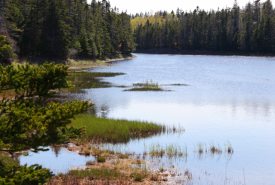Boreal forest

Salmonier River, Avalon Peninsula, NL (Photo by Mike Dembeck)
Few Canadians realize that we have our own forest region of Amazonian proportions stretching across nearly 60 per cent of the country: the boreal forest. This region is one of the world’s largest biogeoclimatic zones.
As Canada's largest ecosystem, it stretches across all provinces except New Brunswick, PEI and Nova Scotia. Close to 75 per cent of the country’s forests are found here, and they are some of the largest and most intact forests left on Earth.
Almost a third of the boreal forest region is covered in wetlands and lakes, providing habitat for 26 million waterfowl. Most of these wetlands are deep and ancient peatlands that store carbon at the highest rates of any northern ecosystem
What trees are found in the boreal forest?
The boreal forest features a number of coniferous and deciduous trees, including:
- balsam fir
- black spruce
- jack pine
- tamarack
- trembling aspen
- white birch
- white spruce
- willow
What is NCC doing to help protect this habitat?
The Nature Conservancy of Canada (NCC) protected and contributed to many projects in the boreal forest region over the years. They include Nebo in Saskatchewan, Kurian in Manitoba, Salmonier River in Newfoundland. NCC also helped bring together unique partnership between the Tallcree Tribal Government, the governments of Alberta and Canada and Syncrude Canada contributed to the creation of the Birch River Wildland Provincial Park. One of NCC’s latest projects is Boreal Wildlands in northern Ontario.





